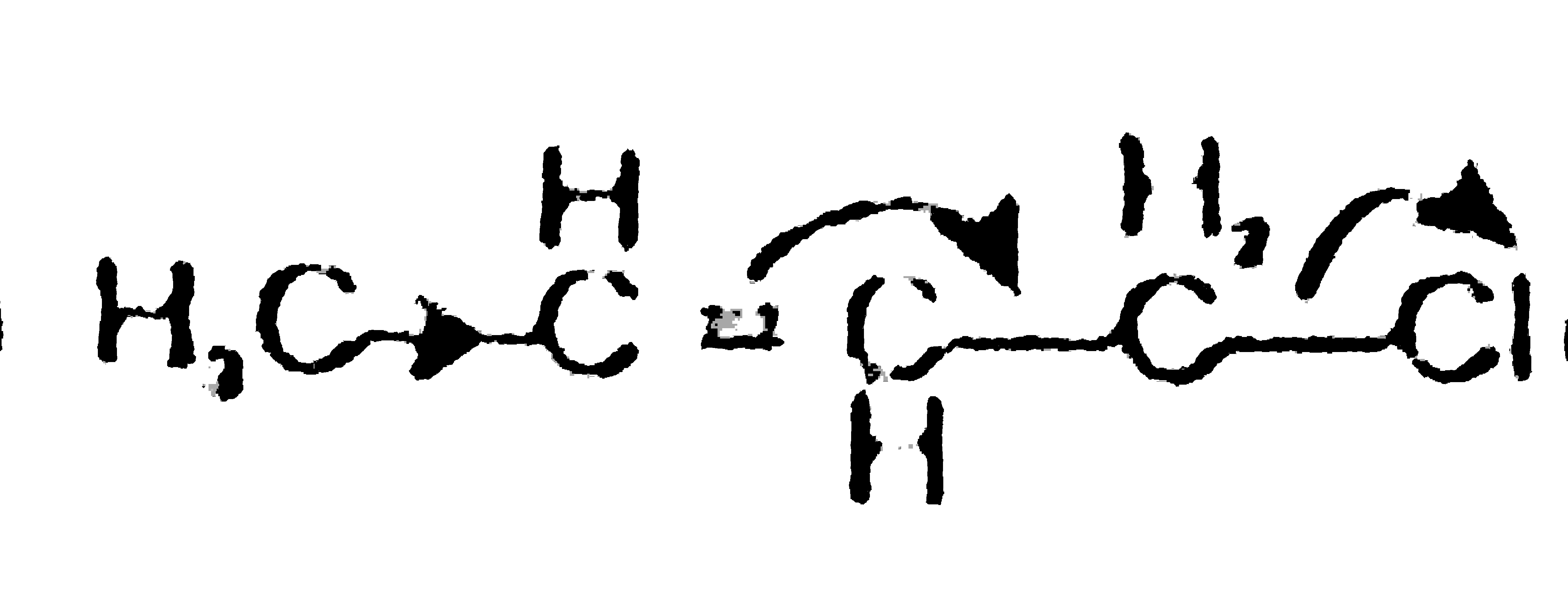Which of the following is the most correct electron displacement for a nuclephilic reaction to take place ?




The correct Answer is:B
To determine the most correct electron displacement for a nucleophilic reaction involving the compound CH3CH=CHCH2Cl (1-chlorobut-2-ene), we will analyze the provided options step by step.
1. Identify the Structure:
The compound is 1-chlorobut-2-ene, which can be represented as:
CH3−CH=CH−CH2Cl
Here, the double bond is between the second and third carbons.
2. Analyze Each Option:
- Option A: Nucleophile attacks the second carbon.
- If the nucleophile attacks the second carbon, the double bond shifts to the third carbon, but the chlorine (Cl) does not leave. This results in a negative charge on the second carbon, but the Cl remains attached. Therefore, this displacement is incorrect.
- Option B: Nucleophile attacks the third carbon.
- In this case, the nucleophile attacks the third carbon, causing the double bond to shift to the second carbon. This results in the departure of the chloride ion (Cl-). The chlorine atom leaves because it is a good leaving group, and the third carbon becomes positively charged while the second carbon becomes negatively charged. This is a correct electron displacement for a nucleophilic reaction.
- Option C: Nucleophile attacks the first carbon.
- If the nucleophile attacks the first carbon, the double bond shifts to the second carbon, but again, the Cl does not leave. This does not result in a proper nucleophilic substitution, making this option incorrect.
- Option D: Chlorine is removed without nucleophile attack.
- In this scenario, Cl is removed without any nucleophilic attack, which does not represent a nucleophilic reaction. Thus, this option is also incorrect.
3. Conclusion:
After analyzing all options, we find that Option B is the most correct electron displacement for a nucleophilic reaction to take place. The nucleophile attacks the third carbon, the double bond shifts, and the Cl leaves, resulting in a stable product.
Final Answer:
The most correct electron displacement for a nucleophilic reaction to take place is Option B.
The compound is 1-chlorobut-2-ene, which can be represented as:
CH3−CH=CH−CH2Cl
Here, the double bond is between the second and third carbons.
- Option A: Nucleophile attacks the second carbon.
- If the nucleophile attacks the second carbon, the double bond shifts to the third carbon, but the chlorine (Cl) does not leave. This results in a negative charge on the second carbon, but the Cl remains attached. Therefore, this displacement is incorrect.
- Option B: Nucleophile attacks the third carbon.
- In this case, the nucleophile attacks the third carbon, causing the double bond to shift to the second carbon. This results in the departure of the chloride ion (Cl-). The chlorine atom leaves because it is a good leaving group, and the third carbon becomes positively charged while the second carbon becomes negatively charged. This is a correct electron displacement for a nucleophilic reaction.
- Option C: Nucleophile attacks the first carbon.
- If the nucleophile attacks the first carbon, the double bond shifts to the second carbon, but again, the Cl does not leave. This does not result in a proper nucleophilic substitution, making this option incorrect.
- Option D: Chlorine is removed without nucleophile attack.
- In this scenario, Cl is removed without any nucleophilic attack, which does not represent a nucleophilic reaction. Thus, this option is also incorrect.
After analyzing all options, we find that Option B is the most correct electron displacement for a nucleophilic reaction to take place. The nucleophile attacks the third carbon, the double bond shifts, and the Cl leaves, resulting in a stable product.
The most correct electron displacement for a nucleophilic reaction to take place is Option B.
Topper's Solved these Questions
- HYDROCARBONBOOK - RESONANCE ENGLISHCHAPTER - HYDROCARBONEXERCISE - INORGANIC CHEMISTRY (COORDINATION COMPOUNDS)
7 Videos
- GASEOUS STATEBOOK - RESONANCE ENGLISHCHAPTER - GASEOUS STATEEXERCISE - Exercise-3
1 Videos
- IONIC EQUILIBRIUMBOOK - RESONANCE ENGLISHCHAPTER - IONIC EQUILIBRIUMEXERCISE - partIII one or more than one options correct type
10 Videos
Similar Questions
Knowledge Check
Which of the following reactions is most exothermic ?
A B
B C
C D
D
Which of the following reactions does not take place?
AC2H5Br+KNO2→C2H5−O−N=O+KBrB CC2H5Br+AgCN→C2H5NC+AgBrDC2H5Br+KCN→C2H5NC+KBr
CC2H5Br+AgCN→C2H5NC+AgBrDC2H5Br+KCN→C2H5NC+KBrWhich of the following reactions takes place at anode ?
AReductionBOxidationCDecompositionDDissolution
Which of the following reactions does not take place?
View SolutionWhich of the following reactions does not take place?
View SolutionWhich of the following reaction does not take place ?
View SolutionWhich of the following Diels− Alder reactions do not take place ?
View SolutionWhich of the following involves no displacement or shifting of electrons ?
View Solution
